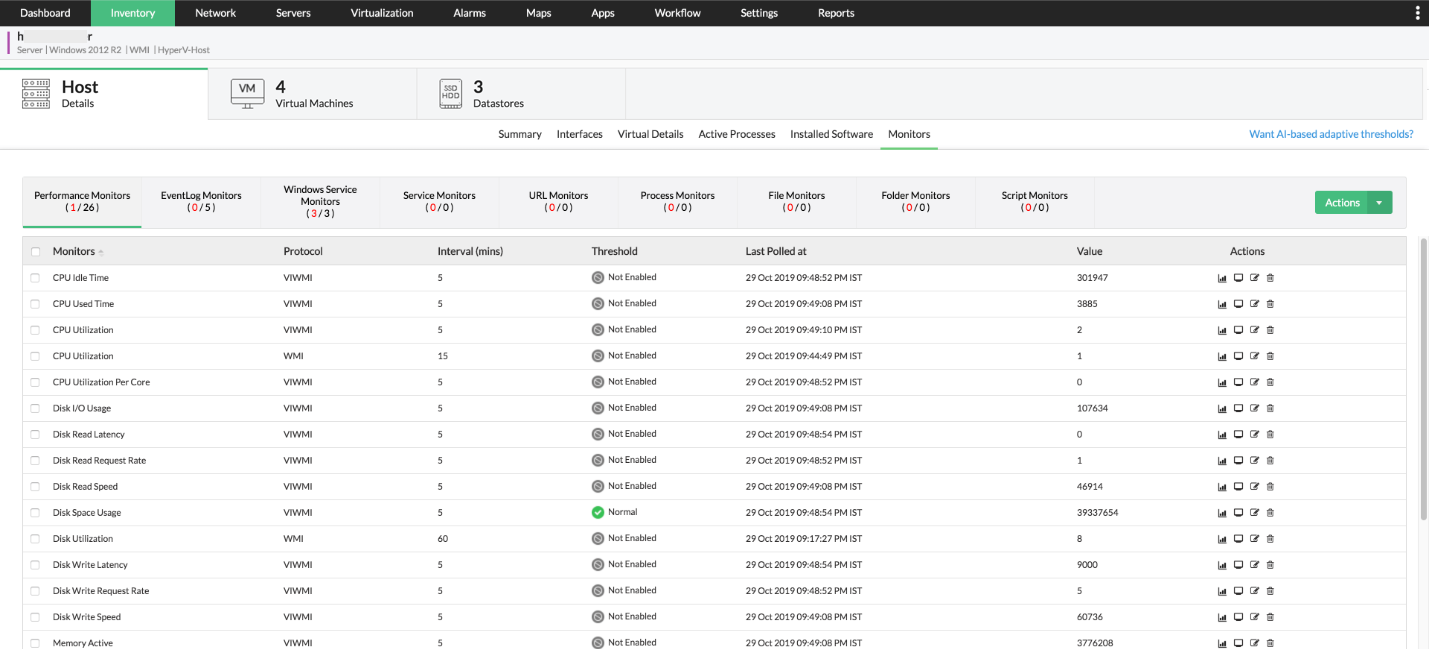Windows Hyper V management requires Hyper server performance management tools. One such tool is the Hyper-V Manager - a VM management tool that comes bundled with the Microsoft Hyper-V. It is a basic tool that lets you create, delete, and manage the VMs, virtual hard disks (VHDs), and more. You can also configure Hyper-V Manager to suit your virtualization needs. With the organizations' ever-increasing IT demands, the Hyper-V Manager is still an unevolved tool that barely meets today's virtual environment management requirements. Effective Hyper-V management tools require the following:
In reality, an IT infrastructure has more than a Hyper-V environment and has diverse hardware from multiple vendors for definite functions. It is not cost-efficient to employ multiple management tools, so what you actually need is a hybrid monitoring and management tool.
OpManager is an all-inclusive Hyper-V performance monitoring tool designed to manage multiple Hyper-V environments. OpManager provides dedicated Hyper-V monitoring tools such as Hyper-V host monitors, individual VM monitors, Hyper-V reports, Hyper-V dashboards, Hyper-V mapper, and more that aid in easy management.
It is nearly impossible for a network administrator to make any strategic decision without understanding the big picture, in this case, the availability and health of the Hyper-V environment. With OpManager's Hyper-V specific dashboards, you can monitor the status of your Windows virtual environment—all in one place. The Hyper-V dashboard lists devices by maximum resource consumption, which helps you keep tabs on your VM and hosts taking up maximum resources, and helps you prevent performance bottlenecks.

Microsoft Hyper-V enables creation of VMs with Windows OS and other OSs, but it supports the WMI protocol only. This leaves you with zero visibility into your VMs running on Linux operating systems. OpManager uses protocols such as WMI, CLI, SNMP, and more which help in monitoring performance of the Hyper-V servers, as well as the VMs running on Windows and Linux operating systems. With more than 40, dedicated Hyper-V performance monitors, you can monitor CPU, memory, Disk I/O, network usage of VMs, and hosts.

Zombie VMs are ones that consume resources, without performing any useful work. This leaves critical VMs running business applications with little to no resources. Also, the network administrator is unable to delete the VMs without knowing why it was created in the first place. An increasing number of Zombie VMs can lead to VM sprawl, which eventually causes performance degradation. This can be eliminated by tracking the VMs. OpManager generates a Hyper-V inventory which helps you track the VMs and the resources used by them in real time. OpManager ensures identification and elimination of potential VM problems. Learn 5 actionable tips to prevent VM sprawl.

Whenever a Hyper-V environment is discovered, OpManager automatically creates a Hyper-V map. This helps IT admins visualize their Hyper-V architecture. The maps also enable the users to map dependencies between various entities, such as VMs to host, VMs to datastore, and hosts to datastore in real time. When OpManager raises an alert on the performance of any physical storage device, you can pinpoint the hosts and VMs in the Hyper-V infrastructure which will be affected with the help of Hyper-V maps. Additionally, the Hyper-V mapper scans the IT infrastructure periodically and automatically updates the dependency maps. This helps network admins make informed decisions.

Hyper-V reports provide comprehensive data of your Hyper-V environment. This helps you track the performance of your VMs over any desired period, and assess your Hyper-V environments, so you can quickly deploy VMs to address future needs. Hyper-V reports in OpManager are highly customizable. With OpManager, you can generate, schedule, and email reports, and export them as PDFs and Excel spreadsheets.

If the Hyper-V faults are not attended in time, the Hyper-V environment might encounter performance issues which could eventually lead to a Hyper-V crash. To ensure this doesn't happen, you can leverage OpManager's Alarm Escalation. Alarm Escalation enables you to escalate Hyper-V alerts to a higher authority if the alarm is not acknowledged. Alarm Escalation is entirely customizable. You can select the desired Hyper-V server(s), define conditions, and escalate alarms to individuals based on your preferences. You can also notify Hyper-V faults via SMS and e-mails, Slack channels, and more directly within OpManager.

In addition to monitoring your Hyper-V environment, it is crucial to monitor the physical servers, interfaces, and storage devices utilized by the VMs. This helps you establish a reliable Hyper-V environment that ensures business services are free from disruptions 24/7.
With OpManager, you can proactively monitor Hyper-V Manager performance, servers, interfaces, switches, routers, firewalls, Xenservers, VMware, Nutanix environments and any networking device for faults and performance, and safeguard the health of your IT infrastructure in real time.
Download OpManager now to ensure your Hyper-V management is simple and stress-free!